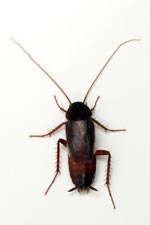Cockroach biology and methods of control
The presence cockroaches in catering and hospitality related premises often strikes immediate fear the in the owner and customers alike. In addition there is the prospect of loss of reputation, goodwill and revenue. Prosecutions can arise under food safety and environmental legislation if the cockroach infestation is not controlled. However the development of novel, professional products including baits and insecticides are now used to readily eradicate cockroache infestations.

Oriental cockroach
The species that are most often encountered are the Oriental cockroach (Blatella orientalis), which is dark brown and 20-25mm long. The other species is the German cockroach (Blatella germanica) which is 12-15mm long and is light yellow/brown. This species is also an avid climber, in contrast to the oriental coackroach which found at floor level. Both species are nocturnal and pests of warm conditions but they can survive cold conditions.
Both cockroach species are unable to breed in conditions below 10 oC. Cockroaches are attracted to food stuffs, putrefying material from waste bins and sewage for liquid intake. It is cross contamination of foods for human consumption and food preparation areas with waste material carried by cockroaches that make these pests a vector for diseases and a hygiene hazard. In addition skin molts of growing cockroaches can cause allergies and exacerbate symptoms of asthma.

German Cockroach
Appropriate measures include the application of specific insecticides with a residual activity and an insect growth regulator to prevent nymphs molting. This methods also affects the breeding cycle.
A very effective approach is by baiting and relies on the cannibalistic tendencies of cockroaches to consume poisons (indoxacarb) contained within the gut. In addition this also provides a “tertiary kill”. Monitoring of treatments is essential, as eggs might hatch many weeks after treatment, especially in case of the oriental coackroach.
